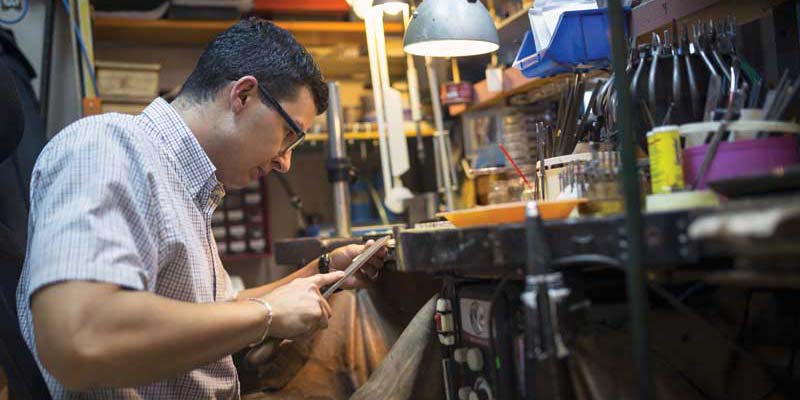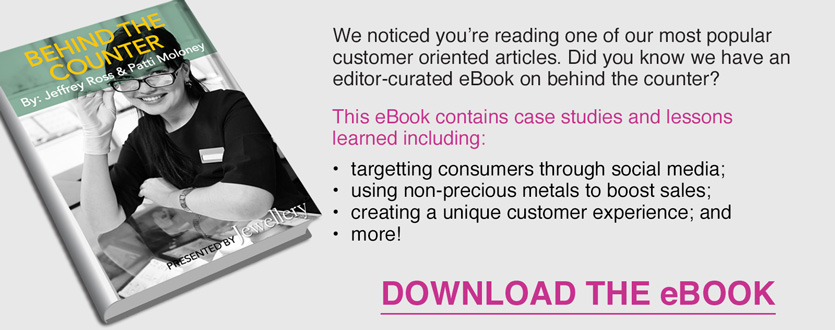From bench to business: Steps to selling your designs wholesale
by Sarah Manning | September 29, 2016 10:01 am
By Kate Hubley

It was 18 months ago, 1:30 a.m. on a Saturday night. I just had a design breakthrough and did a little victory lap around my studio. After my moment of glee, I flopped back into my chair and stared down at my nails, ragged from a six-day marathon at the bench. My to-do list for Sunday was long: invoicing, preparing photos of my new work, a few hours of Photoshopping, updating my website, fixing my sandblaster, tending to my freelance advertising clients, and… oh yes, I have a family, too. I suddenly felt tired. Deflated.
Let’s get down to business
Life at the bench is extremely rewarding for me. I fall into a trance as I file and solder, creating a miniature sculpture with tiny pieces of wax or gold. Despite my thousands of hours in the studio, countless classes a year to add new techniques to my arsenal, and becoming a Fellow of the Gemmological Association of Great Britain (FGA), my jewellery business was not my bread and butter.
Was I becoming a meme? The one where I ask the world to support me for my hard work and exploration because I am a jewellery artist? Perhaps it was time for me to look at my jewellery business as, well, a business!
I decided my best strategy would be to sell my creations to retailers. I would just show them my jewellery and they would fall in love with me and my designs. They would take care of all the selling and I would do all the designing and creating. The orders would start pouring in. Isn’t that how it usually goes? No, actually, it isn’t.
Letting go
One of the first things I needed to do was price out my pieces for wholesale. How could I make a living if I was ‘giving away’ 50 per cent to stores? I needed help with my numbers, so I reached out to an acquaintance whose family owns a chain of well-curated jewellery stores in Montreal. He didn’t give me the magic pricing formula. Instead, he asked me a simple question that made me rethink everything: “What do you want to do, Kate, manufacture or distribute?”
This is probably the biggest existential question for a bench jeweller: do you want to make everything yourself or have help making the pieces, so you can focus on growing your business and building relationships with retailers? You have to answer honestly.

I decided I would distribute—I would hand over the production, so I could create enough volume to actually live off my jewellery. (Plus, I don’t like polishing, so the question sort of answered itself.)
But I still knew nothing about wholesale.
Fast forward to Fall 2015. On a whim, I decided to attend a one-day MJSA jewellery business conference presented as part of ConFab in New York City. There, I discovered the beloved Cindy Edelstein (whose passing earlier this year left a hole in the hearts of countless in the industry) and Andrea Hill, both industry veterans and consultants to jewellery designers and businesses. Their presentation delved deep into the right ways to develop and price collections for wholesale. These were experts in the business of helping jewellery designers grow their businesses. I officially hopped onto the learning curve.
Right brain, meet left brain

Frank Stankus, who carries on his wife Cindy’s legacy, clarifies: “As soon as you intend to sell, you are a business person as much as a designer. If you are going to live off the proceeds of your work, you need to grasp what is required to be in business: your market, the end client, the dynamics of cash flow, etc.”
I had unconsciously become a business woman—a creative entrepreneur. I would need to instill rigour, structure, process, strategy, discipline, and intention in my otherwise topsy-turvy life if this new venture was going to work. “You also need a business plan,” Stankus adds.
Crafting a business plan
A business plan can be an evasive concept for those of us who studied in the arts. In my mind, my plan was quite clear: I would design and sell jewellery to stores. I quickly learned this falls way short of a business plan.
Marlene Richey, author of Profiting by Design—a must for anyone starting a jewellery business—says the first thing you must do as a designer is set goals and define what success looks like to you.
From there, break down your goals and determine how you will achieve them through specific actions completed within a defined schedule. That is your business plan. It doesn’t have to be long and in-depth. It can be a few pages of clearly mapped out actions and benchmarks you refer back to in order to stay on track. Nurturing retailer relationships

Wholesale is all about the relationships—read partnerships—you build with your retailers. Digital communications expert Liz Kantner, of StayGoldJewelry.com, describes the relationship as a courtship, where a retailer has to get to know you before committing. After all, they are ‘investing’ in you when they decide to carry your line.
“Listen to their feedback,” advises Kantner, who also served as marketing and communications director for U.S. designer, Todd Reed. “They are telling you what they need in order to pick up your line, which can often take three years to happen. In the meantime, you have to remain top of mind without being too forceful. So stay positive and patient, be true to who you are, and keep working on your brand—because your brand is what counts.”
Flourish & Thrive Academy’s Robin Kramer shared some additional advice with me during a recent one-on-one: “Remember, retailers are busy working on their business, too. They have to pay rent, staff, insurance, and utilities, so their focus is on getting customers through their doors to make purchases.” Retailers are essentially looking for designers who they believe will help them make that happen.
Designing sellable collections for retailers
Your brand is more than your logo or a cute graphic on your packaging. It goes deeper than your signature style and core values. “You need to differentiate yourself on more than design,” Hill says. “Ask yourself: Who am I? What makes my products different? Why do I matter?” When you have the answers, you will be able to tell your brand story and connect with your customers in a meaningful way.
Edelstein regularly referred to a common affliction: ‘Designer ADD.’ That is, making random, unrelated pretty things. Retailers don’t want that. They are looking for cohesive collections with a central theme. Specifically, all the pieces share a design DNA and tie into your brand message. Your collection also has to have longevity and the potential to evolve over time.
Understanding that many designers do not want to be ‘commercial,’ Richey gives some sage advice about salability: “You want to make a living at your art? Design jewellery that is wearable, beautiful, relevant, well-made, well-priced, and reflects your unique design esthetic.”
From there, you have to ‘romance the jewellery,’ as Stankus says, and tell a compelling story that creates desire for your work and one that the store’s sales staff can repeat to engage their customer. Working with a manufacturer
Can you deliver consistent quality on time? If not, this is a deal breaker. Part of my brand positioning is ‘Made in Montreal. Made in Canada,’ which means I need a local manufacturer. I also need to maintain an open dialogue with my manufacturer, establish standards and expectations, and accept I am ultimately responsible for the quality of my pieces. I learned this the hard way recently when I showed my work to a panel of buyers. After three seconds under the loupe, they pushed it aside like a bowl of cold porridge. It turns out my manufacturer’s best polisher was on vacation right at crunch time. Now, I loupe everything, every time.
Pricing can be so daunting for designers. We are afraid of pricing ourselves out of the running or undervaluing our work. Believe me—you have to be spot on right out of the gate. Fear not, there are specific formulas and approaches to pricing for wholesale that make the exercise quite straightforward.

One method is to base your price on ‘cost of goods,’ which factors in materials, labour, packaging, and other expenses related to the production of the piece. Careful—your labour cost should be based on how much a manufacturer is going to charge you. Many designers will mark the cost of goods up by two or 2.5 times, then add applicable credit card and rep fees.
What about design and development expenditures (e.g. design time, prototypes, or moulds)? Generally, these costs do not factor into your wholesale price. Instead, you have to determine your breakeven point, which is the number of units you need to sell to recuperate this upfront investment.
And overhead? Depending on your business model, you can calculate a percentage and add it to your cost, but that can be finicky, especially if your price points and monthly production vary. The ideal is to focus on creating and promoting a great product available at an attractive wholesale price that sells so well you have the revenue to cover your overhead, pay staff, and give yourself a handsome salary. Because that’s how business works.
Finally, retailers will mark your wholesale price up by two, 2.5, and sometimes three times. Once you have done your calculations, make sure your retail price is in line with what your end consumer would be willing to pay. “If your price is too high, modify your production to bring down your costs,” Hill recommends.
Selling in-store and online

Consumers are indeed making more and more purchases online, and brick-and-mortar retailers are facing challenges in the new economic reality.
Nonetheless, customers still want the in-store experience of touching and trying on jewellery before they buy.
Does this mean you still need a site? Of course! As you build your retailer partnerships, you need one to create brand awareness and make sales. However, your retailers may now view you as the competition. Stankus has these recommendations to maintain trust with them: always keep your prices slightly higher than your manufacturer’s suggested retail price (MSRP), send customers within a given radius to the nearest retailer, and list your retailers prominently on your site.
Getting out of your own way
If you are like most emerging designers, you have a staff of one: you. How do you keep all those plates spinning so your retailers have confidence in you? You need line sheets, order forms, inventory management, photos, customer relationship management (CRM) software, quality control, and the time to design. It is a lot to manage, but can be done if you go into it thinking like a business person.
On a personal note, I can tell you that you have to be open-minded, responsive, and even a little thick skinned if you want to break into the wholesale/retail side of the industry. Everyone you approach will be looking to see how your designs and perceived staying power will help them in their business. It is a little scary, but if you get over your fears, learn not to take the noes personally (remember, retailers have a lot on their mind that has nothing to do with you), and go in well-prepared and organized, it can be an exciting adventure. After all, most people are very, very nice, especially if you can get them excited about you and your work.
Kate Hubley is owner of Montreal design house, K8 Jewelry Concepts Bijoux. She is also a Fellow of the Gemmological Association of Great Britain (FGA) and a 2015 Saul Bell Award recipient. Hubley can be reached at kate@k8jewelry.com.
Source URL: https://www.jewellerybusiness.com/features/from-bench-to-business-steps-to-selling-your-designs-wholesale/

